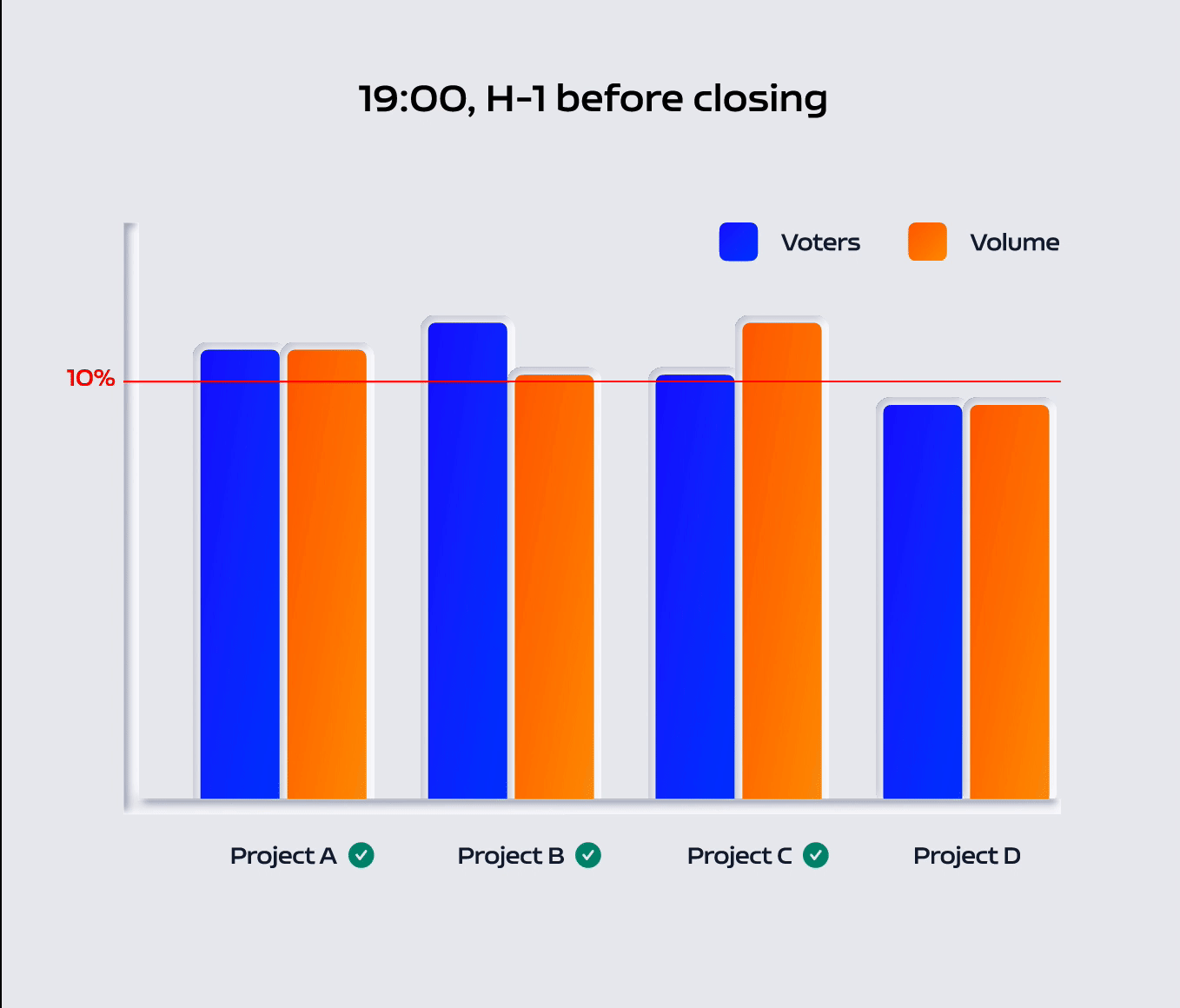The Cardashift voting system: Rules, rewards, and game theory
Our goal is clear: to move towards decentralized governance. That’s why, at the outset, we have set up a voting system to include our community in the project selection process.

Our goal is clear: to move towards decentralized governance. That’s why, at the outset, we have set up a voting system to include our community in the project selection process.
Why is it important for us to allow the community to vote?
The voting phase is about getting the community to help us identify projects for the pre-funding stage. As alluded to in our article — Crypto holders: try impact investing! — a crypto community is composed of investor-citizens. Therefore, as in any democratic system, we want to include community members in the process of finding the projects that will make Cardashift. This system has three objectives:
● To gain insights into community preferences that can inform our decision-making during the rest of the selection process;
● To enable project leaders to discuss their ideas, receive feedback, and seek advice from the Cardano community;
● To boost community members’ confidence while helping them to develop their project assessment skills (by sharing our assessment methods with them)
In the long term we hope to create a community of analysts who can increasingly contribute to, and further develop, the decentralized governance system.
Come as an investor; stay as an active member of an impact-driven community!
General rules of the voting system
Here are the instructions for voting; they will help any investor to participate.
Every two months, community members will be invited to help identify the most promising projects, by participating in a “voting by staking” system, which will run for one month.
Requirements for participation:
● Just one CLAP!
This means that everyone can participate! It’s a bold choice we made to bring more equality and democracy to the selection process. We want to get back to one of blockchain’s original goals — injecting greater equality into the financial system by enabling any community member to choose and invest in the projects of tomorrow.
Basic rules:
● Each member can stake a portion of their CLAP tokens on the projects they like the most
● The maximum stake amount each address can acquire is limited
● Members will receive a 7–8% annualized return on each staking, i.e., 0.6% for a complete month
● It will be possible for a member to switch their vote from project A to project B; however, in that case, they will lose the return on staking accumulated in project A
Rewards for the voter:
● Each member will get back the amount they staked plus interest
● If the project they selected proceeds to the funding round, they will be whitelisted for the private sale
Two metrics for project selection:
1. The volume (total number) of CLAP tokens staked per project call
→ This gives us insights into projects’ funding potential
2. The number of voters (unique addresses) participating in each project call
→ This avoids a plutocratic system where the wealthiest wallets are the only ones to drive the decision
At the end of the staking period, projects that meet the percentage threshold for both of these metrics will be validated by the community and proceed to the next step.
Difficult to digest?
Here’s an example:
It’s the last day of the voting period — at the closing time, here are the figures:
● 20 projects in the cohort
● 100 members have voted
● 10,000 CLAPs in stake
● Percentage threshold of 10%, i.e., 10 voters and 1,000 CLAPs
4 projects are in the lead:
Results: Projects A & B are selected for the next step. Project C & D are not.
Convinced by our system?
Want to be a part of it?
Assigning the community a key role in the selection process is an exploratory approach. In the interests of transparency, we want to expound on the rationale underpinning the system, and to include all the members in our discussions about it. So, for those who are keen on game theory, here’s how the system incentivizes participants to make informed decisions.
A system resilient to slick characters!
Disincentivizing ‘slick characters’
The main potential pain point is opportunistic members who do not stake during the 1-month period, then, just before the end of the process, put 1 CLAP on a project which has already cleared the threshold.
If such opportunistic members make up a significant share of voters, that may distort the outcome of the vote.
Let us illustrate this point using an example. Imagine the following situation:
● Number of projects in the batch: 20
● CLAPs volume staked: 10,000 CLAPs
● Current number of voters: 100
● Threshold: 10%
Now, let’s assume that 10 members, who haven’t yet staked, choose to put 1 CLAP each on project A, so as to be sure that they get whitelisted for a potential upcoming private sale.
It’s fair to say that these 10 new investors just went with the flow and didn’t actually cast an informed vote.
However, due to the last-minute intervention of the aforementioned 10 investors, the state of play at closing looks like this:

This poses two ethical conundrums:
- Whilst the launchpad claims to foster sustainable development, speculative investments have precluded potentially impactful projects from being selected
- Investors who made an informed decision to vote for projects B & C feel cheated by this system
So, the voting system doesn’t work?!
Well, actually…
A little bit of game theory shows us the resilience of the staking system
The risk of last-minute opportunist voters is real, but we believe that the staking system acts as a corrective mechanism, ensuring that voting decisions are as informed as possible. The staking system incentivizes investors to choose their favorite projects at the beginning of the 1-month voting period. This is because the more time they stake, the more they stand to gain.
Investors, being rational actors, will choose their favorite projects from the very beginning. In so doing, from a game theory perspective, this ensures that the system works.
Let’s be more precise:
According to Rasmusen’s theory, information is deemed complete if every player is aware of the following from the very beginning:
- the possible actions he can take
- the possible actions the other players can take
- the possible rewards for his or her actions
- the other players’ objectives
However, a game can have complete, but imperfect, information, meaning the investor doesn’t know the other members’ moves. This is indeed the case here.
This means the investor has three options:
- To wait for the others to make the first move to be sure to stake on the right project → The reduced staking reward makes this less attractive.
- To pick projects rationally, assuming that most investors will do the same, and reach the same conclusion as him/herself.
- To make uninformed and risky assumptions about which projects could meet the threshold → This is unattractive, given that one can easily reduce risk by conducting a quick analysis of the different projects, which takes us back to the previous bullet point.
Are you convinced?
Follow us on Discord & share your opinion! 🔥
You can also follow us on Twitter and learn more about us on our Website.⚡️
Written by Yannis Baala & Anaïs Bouchet — Impact Project Managers
Delegate Your Voting Power to FEED DRep in Cardano Governance.
DRep ID: drep12ukt4ctzmtf6l5rj76cddgf3dvuy0lfz7uky08jfvgr9ugaapz4 | We are driven to register as a DRep by our deep dedication to the Cardano ecosystem and our aspiration to take an active role in its development, ensuring that its progress stays true to the principles of decentralization, security, and community empowerment.DELEGATE VOTING POWER!







